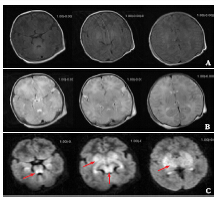 PDF(1810 KB)
PDF(1810 KB)


Types of acute hypoxic-ischemic brain injury due to perinatal sentinel events in neonates
WANG Ying-Jie, MAO Jian
Chinese Journal of Contemporary Pediatrics ›› 2014, Vol. 16 ›› Issue (6) : 589-595.
 PDF(1810 KB)
PDF(1810 KB)
 PDF(1810 KB)
PDF(1810 KB)
Types of acute hypoxic-ischemic brain injury due to perinatal sentinel events in neonates
Objective To investigate the clinical and imaging characteristics of acute hypoxic-ischemic brain injury (HIBI) due to perinatal sentinel events in neonates. Methods Forty-six neonates with acute HIBI who were admitted between January 2004 and May 2013, and who had a history of major cardiopulmonary resuscitation, were enrolled in the study. They were classified into full-term and preterm infants to analyze the clinical and imaging characteristics. Results Among full-term infants, the incidence rates of white matter injury, cortical injury, basal ganglia /thalamic injury, and brain stem injury were 95%, 90%, 75%, and 65%, respectively; among preterm infants, the incidence rates of white matter injury, cortical injury, basal ganglia/thalamic injury, and brain stem injury were 73%, 23%, 19%, and 15%, respectively. Compared with full-term infants, preterm infants had a significantly lower incidence of gray matter injury in the cortex, basal ganglia/thalamus, and brain stem (P<0.05). About 46% of all subjects had multiple organ dysfunction. The 20 full-term infants with HIBI had typical clinical manifestations; 19 (95%) of them had moderate or severe neonatal encephalopathy, with mixed lesions on magnetic resonance imaging (MRI), and moderate or severe basal ganglia/thalamic injury was found in 68% of these patients. Multiple organ dysfunction, various abnormal neurological manifestations, and arterial blood pH less than 7.1 were closely related to moderate or severe brain injury. Conclusions White matter injury is the most common type of HIBI. Gray matter injury can be found in preterm infants, but the incidence is lower than that in full-term infants. Moderate or severe neonatal encephalopathy is mainly manifested as basal ganglia/thalamic injury on MRI. Evaluation of multiple organ dysfunction and abnormal neurological manifestations and early blood gas analysis are very important for the diagnosis of neonatal HIBI.

Hypoxic-ischemic brain injury / Cardiopulmonary resuscitation / Basal ganglia / White matter / Neonate